Belts Hyundai Accent 2011 Owner's Guide
[x] Cancel search | Manufacturer: HYUNDAI, Model Year: 2011, Model line: Accent, Model: Hyundai Accent 2011Pages: 282, PDF Size: 14.82 MB
Page 52 of 282
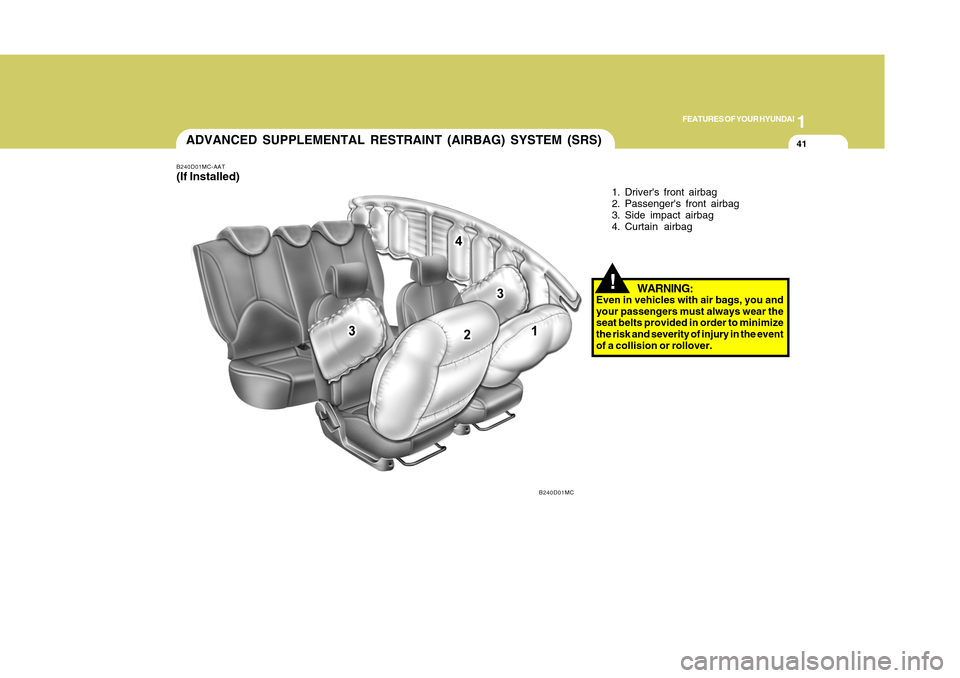
1
FEATURES OF YOUR HYUNDAI
411
FEATURES OF YOUR HYUNDAI
41
B240D01MC-AAT(If Installed)ADVANCED SUPPLEMENTAL RESTRAINT (AIRBAG) SYSTEM (SRS)
1. Driver's front airbag
2. Passenger's front airbag
3. Side impact airbag
4. Curtain airbag
B240D01MC
!
WARNING:
Even in vehicles with air bags, you and
your passengers must always wear the
seat belts provided in order to minimize
the risk and severity of injury in the event
of a collision or rollover.
Page 53 of 282

1FEATURES OF YOUR HYUNDAI42
B240A01MC
The purpose of the SRS is to provide the
vehicle's driver and/or the front passen-
ger with additional protection than that
offered by the seat belt system alone in
case of a frontal impact of sufficient sever-
ity. The SRS uses sensors to gather infor-
mation about the driver's and front
passenger's seat position, the driver's and
front passenger's seat belt usage and
impact severity.
The driver's and front passenger's seat
track position sensors (If Installed), which
are installed on the seat track, determine
if the seats are fore or aft of a reference
position. The seat belt buckle sensors
determine if the driver and front
passenger's seat belts are fastened.
These sensors provide the ability to con-
trol the SRS deployment based on how
close the driver's seat is to the steering
wheel, how close the passenger's seat is
to the instrument panel, whether or not
the seat belts are fastened, and how
severe the impact is.The advanced SRS offers the ability to
control the airbag inflation within two lev-
els. A first stage level is provided for
moderate-severity impacts. A second
stage level is provided for more severe
impacts.
According to the impact severity, seating
position and seat belt usage, the
SRSCM(SRS Control Module) controls
the airbag inflation. Failure to properly
wear seat belts can increase the risk or
severity of injury in an accident.
Additionally, your Hyundai is equipped
with an occupant classification system in
the front passenger's seat. The occupant
classification system detects the pres-
ence of a passenger in the front
passenger's seat and will turn off the front
passenger's airbag under certain condi-
tions. For more detail, see "Occupant Clas-
sification System" later in this section.
B240A03NF-AATDriver's and Passenger's Front
AirbagYour Hyundai is equipped with an ad-
vanced Supplemental Restraint (Airbag)
System and lap/shoulder belts at both the
driver and passenger seating positions.
The indications of the system's presence
are the letters "SRS AIRBAG" embossed
on the airbag pad cover in the steering
wheel and the passenger's side front
panel pad above the glove box.
The Hyundai SRS consists of airbags
installed under the pad covers in the
center of the steering wheel and the
passenger's side front panel above the
glove box.Driver's Front Airbag
Page 54 of 282
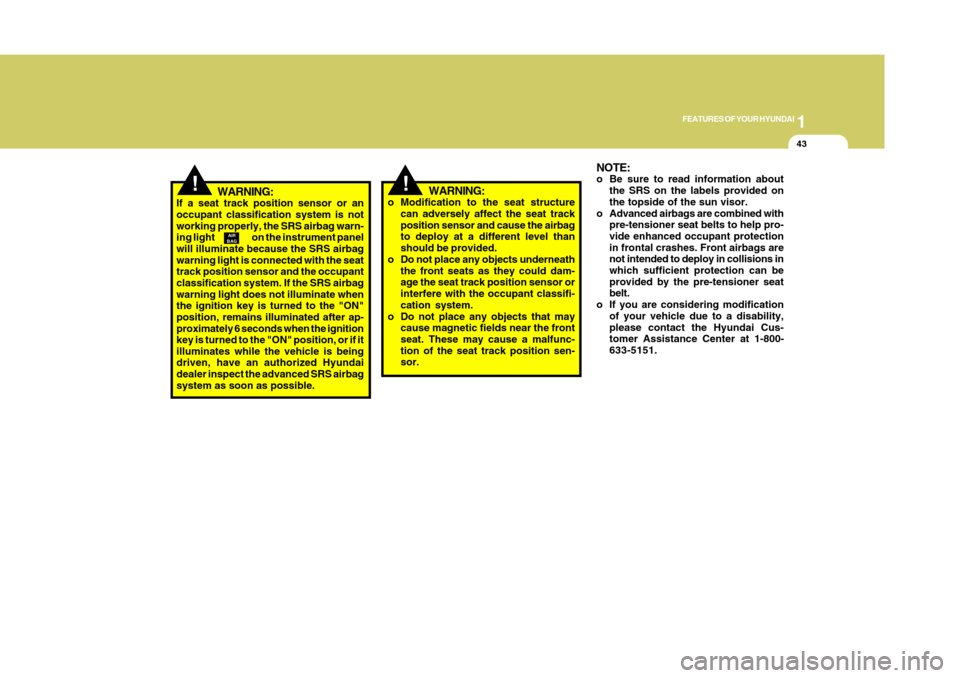
1
FEATURES OF YOUR HYUNDAI
431
FEATURES OF YOUR HYUNDAI
43
!
WARNING:
If a seat track position sensor or an
occupant classification system is not
working properly, the SRS airbag warn-
ing light on the instrument panel
will illuminate because the SRS airbag
warning light is connected with the seat
track position sensor and the occupant
classification system. If the SRS airbag
warning light does not illuminate when
the ignition key is turned to the "ON"
position, remains illuminated after ap-
proximately 6 seconds when the ignition
key is turned to the "ON" position, or if it
illuminates while the vehicle is being
driven, have an authorized Hyundai
dealer inspect the advanced SRS airbag
system as soon as possible.
AIR
BAG
!
WARNING:
o Modification to the seat structure
can adversely affect the seat track
position sensor and cause the airbag
to deploy at a different level than
should be provided.
o Do not place any objects underneath
the front seats as they could dam-
age the seat track position sensor or
interfere with the occupant classifi-
cation system.
o Do not place any objects that may
cause magnetic fields near the front
seat. These may cause a malfunc-
tion of the seat track position sen-
sor.
NOTE:o Be sure to read information about
the SRS on the labels provided on
the topside of the sun visor.
o Advanced airbags are combined with
pre-tensioner seat belts to help pro-
vide enhanced occupant protection
in frontal crashes. Front airbags are
not intended to deploy in collisions in
which sufficient protection can be
provided by the pre-tensioner seat
belt.
o If you are considering modification
of your vehicle due to a disability,
please contact the Hyundai Cus-
tomer Assistance Center at 1-800-
633-5151.
Page 55 of 282

1FEATURES OF YOUR HYUNDAI44
!
WARNING:
o Move your seat as far back as prac-
tical from the front airbags, while still
maintaining control of the vehicle.
o Never sit or lean unnecessarily close
to the front or side airbags.
o Never lean against the door or cen-
ter console – always sit in an upright
position.
o Do not allow an adult passenger to
ride in the front seat when the “Pas-
senger Airbag OFF” indicator is illu-
minated, because the airbag will not
deploy in the event of a moderate or
severe frontal crash.
o Never place objects over or near
any airbag module (front or side im-
pact airbags), because these objects
can injure passengers in a crash.
o Never place covers, blankets or
aftermarket seat warmers on the
passenger seat as these may inter-
fere with the occupant classification
system.
!
WARNING:
Always use seat belts and child restraints
– every trip, every time, everyone!
Airbags inflate with considerable force
and in the blink of an eye. Seat belts help
keep occupants in proper position to
obtain maximum benefit from the airbag.
Even with advanced airbags, improp-
erly belted and unbelted occupants can
be severely injured when the airbag in-
flates. Always follow the precautions
about seat belts, airbags and occupant
safety contained in this manual.
To reduce the chance of serious or fatal
injuries and receive the maximum safety
benefit from your restraint system:
o Never place a child in any child or
booster seat in the front seat (see
child restraints 1-31).
o ABC – Always Buckle Children in the
back seat. It is the safest place for
children of any age to ride.
o Front and side impact airbags can
injure occupants improperly posi-
tioned in the front seats.
!
WARNING:
o Do not tamper or disconnect SRS
wiring or other components. Injuries
could result from inadvertent deploy-
ment or failure of the airbag to de-
ploy in a crash.
o If the SRS airbag warning light (see
pg 1-64) remains illuminated while
the vehicle is being driven, have an
authorized Hyundai dealer inspect
the airbag system as soon as pos-
sible.
o Airbags can only be used once –
have an authorized Hyundai dealer
replace the airbag immediately after
deployment.
o The SRS is designed to deploy the
front airbags only when an impact is
sufficiently severe and when the im-
pact angle is within a range as mea-
sured from the forward longitudinal
axis of the vehicle. The front airbags
will not deploy in side, rear or rollover
impacts. Additionally, the airbags will
only deploy once. Seat belts must be
worn at all times.
Page 56 of 282
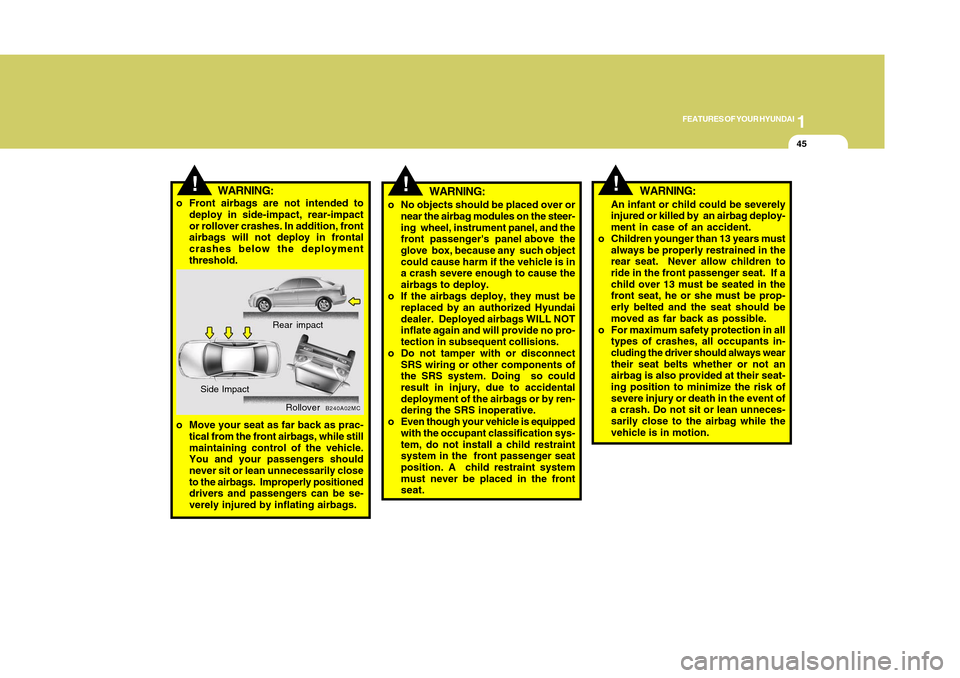
1
FEATURES OF YOUR HYUNDAI
451
FEATURES OF YOUR HYUNDAI
45
!
WARNING:
o No objects should be placed over or
near the airbag modules on the steer-
ing wheel, instrument panel, and the
front passenger's panel above the
glove box, because any such object
could cause harm if the vehicle is in
a crash severe enough to cause the
airbags to deploy.
o If the airbags deploy, they must be
replaced by an authorized Hyundai
dealer. Deployed airbags WILL NOT
inflate again and will provide no pro-
tection in subsequent collisions.
o Do not tamper with or disconnect
SRS wiring or other components of
the SRS system. Doing so could
result in injury, due to accidental
deployment of the airbags or by ren-
dering the SRS inoperative.
o Even though your vehicle is equipped
with the occupant classification sys-
tem, do not install a child restraint
system in the front passenger seat
position. A child restraint system
must never be placed in the front
seat.
An infant or child could be severely
injured or killed by an airbag deploy-
ment in case of an accident.
o Children younger than 13 years must
always be properly restrained in the
rear seat. Never allow children to
ride in the front passenger seat. If a
child over 13 must be seated in the
front seat, he or she must be prop-
erly belted and the seat should be
moved as far back as possible.
o For maximum safety protection in all
types of crashes, all occupants in-
cluding the driver should always wear
their seat belts whether or not an
airbag is also provided at their seat-
ing position to minimize the risk of
severe injury or death in the event of
a crash. Do not sit or lean unneces-
sarily close to the airbag while the
vehicle is in motion.!
WARNING:
!
WARNING:
B240A02MC
Rear impact
Side Impact
Rollover
o Front airbags are not intended to
deploy in side-impact, rear-impact
or rollover crashes. In addition, front
airbags will not deploy in frontal
crashes below the deployment
threshold.
o Move your seat as far back as prac-
tical from the front airbags, while still
maintaining control of the vehicle.
You and your passengers should
never sit or lean unnecessarily close
to the airbags. Improperly positioned
drivers and passengers can be se-
verely injured by inflating airbags.
Page 64 of 282
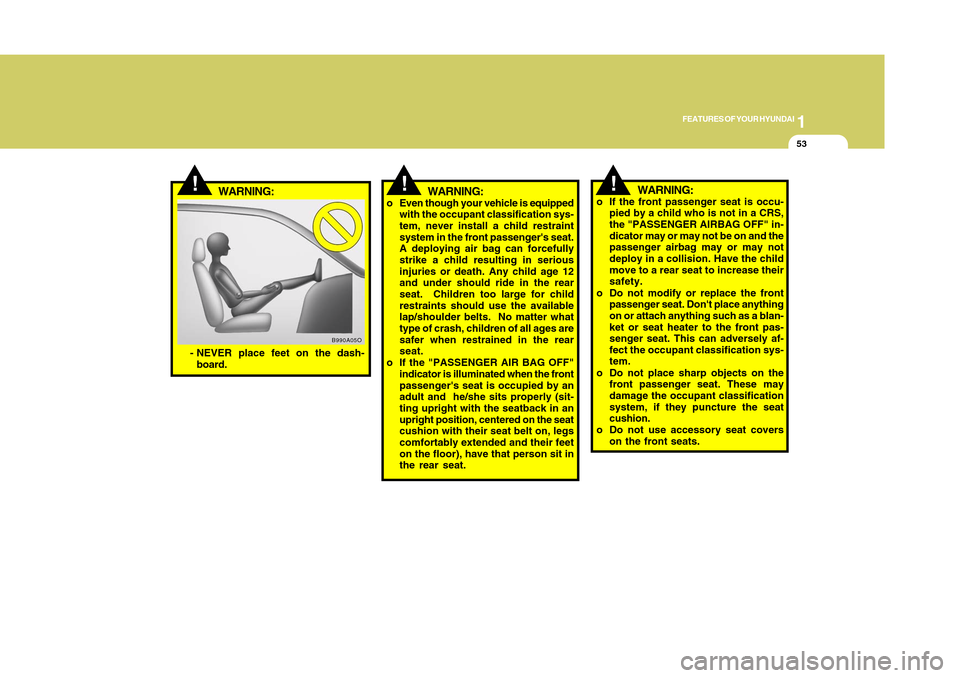
1
FEATURES OF YOUR HYUNDAI
531
FEATURES OF YOUR HYUNDAI
53
!
WARNING:
!
!
WARNING:
o Even though your vehicle is equipped
with the occupant classification sys-
tem, never install a child restraint
system in the front passenger's seat.
A deploying air bag can forcefully
strike a child resulting in serious
injuries or death. Any child age 12
and under should ride in the rear
seat. Children too large for child
restraints should use the available
lap/shoulder belts. No matter what
type of crash, children of all ages are
safer when restrained in the rear
seat.
o If the "PASSENGER AIR BAG OFF"
indicator is illuminated when the front
passenger's seat is occupied by an
adult and he/she sits properly (sit-
ting upright with the seatback in an
upright position, centered on the seat
cushion with their seat belt on, legs
comfortably extended and their feet
on the floor), have that person sit in
the rear seat.
B990A05O
- NEVER place feet on the dash-
board.
WARNING:
o If the front passenger seat is occu-
pied by a child who is not in a CRS,
the "PASSENGER AIRBAG OFF" in-
dicator may or may not be on and the
passenger airbag may or may not
deploy in a collision. Have the child
move to a rear seat to increase their
safety.
o Do not modify or replace the front
passenger seat. Don't place anything
on or attach anything such as a blan-
ket or seat heater to the front pas-
senger seat. This can adversely af-
fect the occupant classification sys-
tem.
o Do not place sharp objects on the
front passenger seat. These may
damage the occupant classification
system, if they puncture the seat
cushion.
o Do not use accessory seat covers
on the front seats.
Page 66 of 282
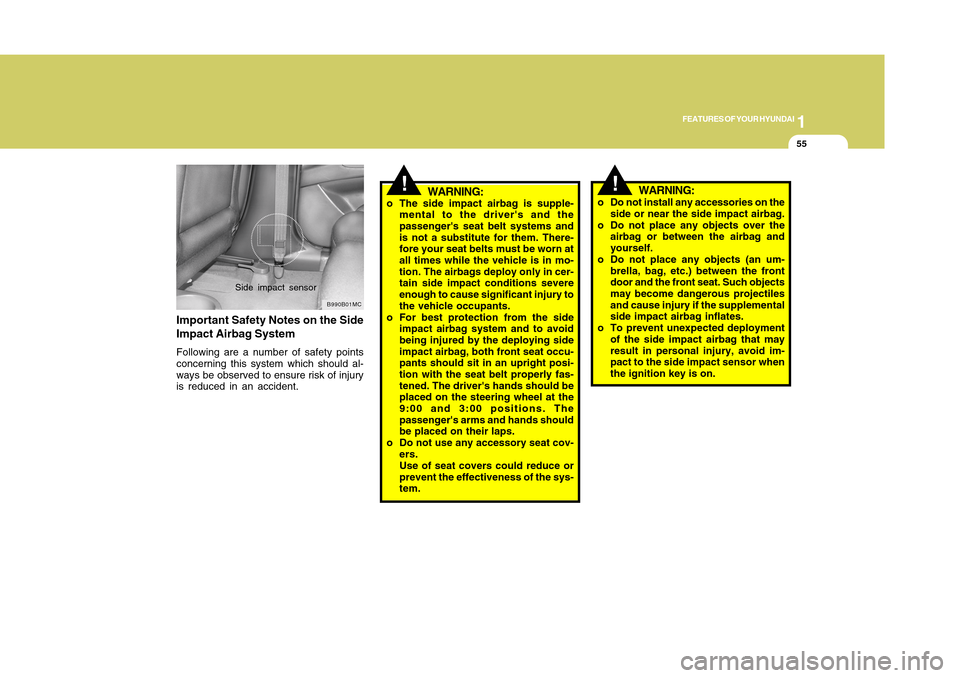
1
FEATURES OF YOUR HYUNDAI
551
FEATURES OF YOUR HYUNDAI
55
WARNING:
o The side impact airbag is supple-
mental to the driver's and the
passenger's seat belt systems and
is not a substitute for them. There-
fore your seat belts must be worn at
all times while the vehicle is in mo-
tion. The airbags deploy only in cer-
tain side impact conditions severe
enough to cause significant injury to
the vehicle occupants.
o For best protection from the side
impact airbag system and to avoid
being injured by the deploying side
impact airbag, both front seat occu-
pants should sit in an upright posi-
tion with the seat belt properly fas-
tened. The driver's hands should be
placed on the steering wheel at the
9:00 and 3:00 positions. The
passenger's arms and hands should
be placed on their laps.
o Do not use any accessory seat cov-
ers.
Use of seat covers could reduce or
prevent the effectiveness of the sys-
tem.
!
B990B01MC
Side impact sensor
Important Safety Notes on the Side
Impact Airbag SystemFollowing are a number of safety points
concerning this system which should al-
ways be observed to ensure risk of injury
is reduced in an accident.
!
o Do not install any accessories on the
side or near the side impact airbag.
o Do not place any objects over the
airbag or between the airbag and
yourself.
o Do not place any objects (an um-
brella, bag, etc.) between the front
door and the front seat. Such objects
may become dangerous projectiles
and cause injury if the supplemental
side impact airbag inflates.
o To prevent unexpected deployment
of the side impact airbag that may
result in personal injury, avoid im-
pact to the side impact sensor when
the ignition key is on.
WARNING:
Page 69 of 282

1FEATURES OF YOUR HYUNDAI58
B240D02NF-AATAdditional Safety PrecautionsoNever let passengers ride in the
cargo area (trunk) or on top of a
folded-down back seat. All occupants
should sit upright, fully back in their
seats with their seat belts on and their
feet on the floor.
oPassengers should not move out of
or change seats while the vehicle is
moving. A passenger who is not wear-
ing a seat belt during a crash or emer-
gency stop can be thrown against the
inside of the vehicle, against other
occupants, or out of the vehicle.
oEach seat belt is designed to re-
strain one occupant. If more than one
person uses the same seat belt, they
could be seriously injured or killed in
a collision.
oDo not use any accessories on seat
belts. Devices claiming to improve oc-
cupant comfort or reposition the seat
belt can reduce the protection pro-
vided by the seat belt and increase the
chance of serious injury in a crash.
oPassengers should not place hard or
sharp objects between themselves
and the airbags. Carrying hard or
sharp objects on your lap or in your
mouth can result in injuries if an airbag
inflates.
!
WARNING:
o No objects should be placed over or
near the airbag modules on the steer-
ing wheel, instrument panel, and the
front passenger's panel above the
glove box, because any such object
could cause harm if the vehicle is in
a crash severe enough to cause the
airbags to inflate.
o If the airbags inflate, they must be
replaced by an authorized Hyundai
dealer.
o Do not tamper with or disconnect
SRS wiring, or other components of
the SRS system. Doing so could re-
sult in injury, due to accidental infla-
tion of the airbags or by rendering
the SRS inoperative.
o If components of the airbag system
must be discarded, or if the vehicle
must be scrapped, certain safety
precautions must be observed. Your
Hyundai dealer knows these precau-
tions and can give you the neces-
sary information. Failure to follow
these precautions and procedures
could increase the risk of personal
injury.
!
WARNING:
o If your car was flooded and has
soaked carpeting or there is water
on the floor, do not start the engine;
have the car towed to an authorized
Hyundai dealer.
Page 70 of 282
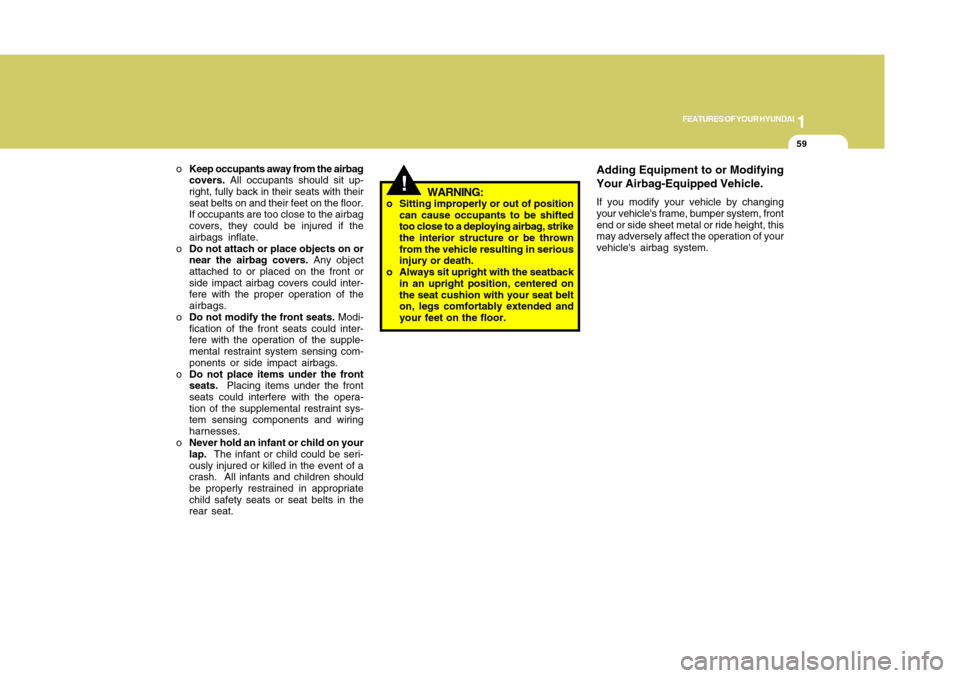
1
FEATURES OF YOUR HYUNDAI
591
FEATURES OF YOUR HYUNDAI
59
!
WARNING:
o Sitting improperly or out of position
can cause occupants to be shifted
too close to a deploying airbag, strike
the interior structure or be thrown
from the vehicle resulting in serious
injury or death.
o Always sit upright with the seatback
in an upright position, centered on
the seat cushion with your seat belt
on, legs comfortably extended and
your feet on the floor. oKeep occupants away from the airbag
covers. All occupants should sit up-
right, fully back in their seats with their
seat belts on and their feet on the floor.
If occupants are too close to the airbag
covers, they could be injured if the
airbags inflate.
oDo not attach or place objects on or
near the airbag covers. Any object
attached to or placed on the front or
side impact airbag covers could inter-
fere with the proper operation of the
airbags.
oDo not modify the front seats. Modi-
fication of the front seats could inter-
fere with the operation of the supple-
mental restraint system sensing com-
ponents or side impact airbags.
oDo not place items under the front
seats. Placing items under the front
seats could interfere with the opera-
tion of the supplemental restraint sys-
tem sensing components and wiring
harnesses.
oNever hold an infant or child on your
lap. The infant or child could be seri-
ously injured or killed in the event of a
crash. All infants and children should
be properly restrained in appropriate
child safety seats or seat belts in the
rear seat.
Adding Equipment to or Modifying
Your Airbag-Equipped Vehicle.If you modify your vehicle by changing
your vehicle's frame, bumper system, front
end or side sheet metal or ride height, this
may adversely affect the operation of your
vehicle's airbag system.
Page 186 of 282

3
WHAT TO DO IN AN EMERGENCY
5
!!
WARNING:
While the engine is running, keep hands,
long hair and clothing away from mov-
ing parts such as the fan and drive belts
to prevent injury.
5. If the water pump drive belt is broken
or coolant is leaking out, stop the en-
gine immediately and call the nearest
Hyundai dealer for assistance.
WARNING:
Do not remove the radiator cap when
the engine is hot. This may result in
coolant being blown out of the opening
and cause serious burns.
!
6. If you cannot find the cause of the
overheating, wait until the engine tem-
perature has returned to normal. Then,
if coolant has been lost, carefully add
water to the reservoir (Page 6-8) to
bring the fluid level in the reservoir up
to the halfway mark.
7. Proceed with caution, keeping alert for
further signs of overheating. If over-
heating happens again, call a Hyundai
dealer for assistance.
CAUTION:
Serious loss of coolant indicates there
is a leak in the cooling system and this
should be checked as soon as possible
by a Hyundai dealer.
TIRE PRESSURE MONITOR-
ING SYSTEM (TPMS)
C320A01TG C320A01MC-AAT
(If Installed)
➀ Low Tire Pressure Telltale
➁ TPMS Malfunction Indicator
Each tire, including the spare (if pro-
vided), should be checked monthly
when cold and inflated to the inflation
pressure recommended by the vehicle
manufacturer on the vehicle placard or
tire inflation pressure label. (If your
vehicle has tires of a different size
than the size indicated on the vehicle
placard or tire inflation pressure label,
you should determine the proper tire
inflation pressure for those tires.)